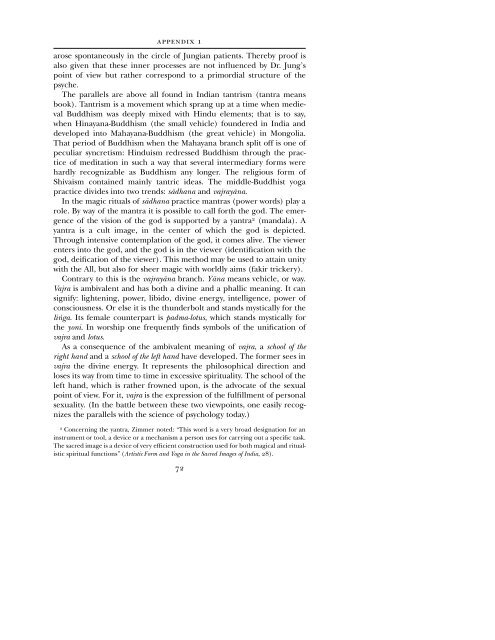CG JUNG - Countryside Anarchist
CG JUNG - Countryside Anarchist
CG JUNG - Countryside Anarchist
You also want an ePaper? Increase the reach of your titles
YUMPU automatically turns print PDFs into web optimized ePapers that Google loves.
APPENDIX 1<br />
arose spontaneously in the circle of Jungian patients. Thereby proof is<br />
also given that these inner processes are not influenced by Dr. Jung’s<br />
point of view but rather correspond to a primordial structure of the<br />
psyche.<br />
The parallels are above all found in Indian tantrism (tantra means<br />
book). Tantrism is a movement which sprang up at a time when medieval<br />
Buddhism was deeply mixed with Hindu elements; that is to say,<br />
when Hinayana-Buddhism (the small vehicle) foundered in India and<br />
developed into Mahayana-Buddhism (the great vehicle) in Mongolia.<br />
That period of Buddhism when the Mahayana branch split off is one of<br />
peculiar syncretism: Hinduism redressed Buddhism through the practice<br />
of meditation in such a way that several intermediary forms were<br />
hardly recognizable as Buddhism any longer. The religious form of<br />
Shivaism contained mainly tantric ideas. The middle-Buddhist yoga<br />
practice divides into two trends: svdhana and vajrayvna.<br />
In the magic rituals of svdhana practice mantras (power words) play a<br />
role. By way of the mantra it is possible to call forth the god. The emergence<br />
of the vision of the god is supported by a yantra 2 (mandala). A<br />
yantra is a cult image, in the center of which the god is depicted.<br />
Through intensive contemplation of the god, it comes alive. The viewer<br />
enters into the god, and the god is in the viewer (identification with the<br />
god, deification of the viewer). This method may be used to attain unity<br />
with the All, but also for sheer magic with worldly aims (fakir trickery).<br />
Contrary to this is the vajrayvna branch. Yvna means vehicle, or way.<br />
Vajra is ambivalent and has both a divine and a phallic meaning. It can<br />
signify: lightening, power, libido, divine energy, intelligence, power of<br />
consciousness. Or else it is the thunderbolt and stands mystically for the<br />
li´ga. Its female counterpart is padma-lotus, which stands mystically for<br />
the yoni. In worship one frequently finds symbols of the unification of<br />
vajra and lotus.<br />
As a consequence of the ambivalent meaning of vajra, aschool of the<br />
right hand and a school of the left hand have developed. The former sees in<br />
vajra the divine energy. It represents the philosophical direction and<br />
loses its way from time to time in excessive spirituality. The school of the<br />
left hand, which is rather frowned upon, is the advocate of the sexual<br />
point of view. For it, vajra is the expression of the fulfillment of personal<br />
sexuality. (In the battle between these two viewpoints, one easily recognizes<br />
the parallels with the science of psychology today.)<br />
2 Concerning the yantra, Zimmer noted: “This word is a very broad designation for an<br />
instrument or tool, a device or a mechanism a person uses for carrying out a specific task.<br />
The sacred image is a device of very efficient construction used for both magical and ritualistic<br />
spiritual functions” (Artistic Form and Yoga in the Sacred Images of India, 28).<br />
72


